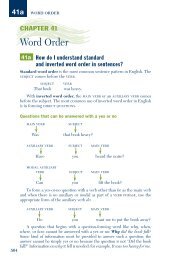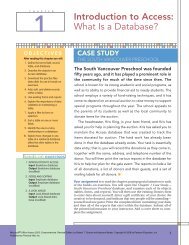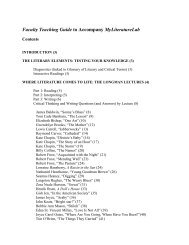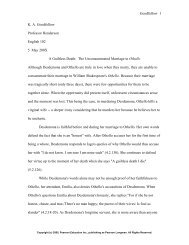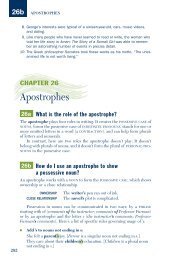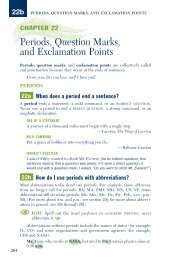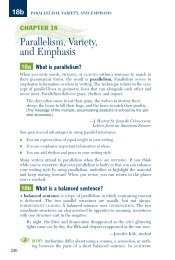chapter 3 - Pearson Learning Solutions
chapter 3 - Pearson Learning Solutions
chapter 3 - Pearson Learning Solutions
You also want an ePaper? Increase the reach of your titles
YUMPU automatically turns print PDFs into web optimized ePapers that Google loves.
2009934667<br />
taste communicates. It encompasses the communication aspects of such factors as<br />
the classifications of taste, the role of culture on taste, the role of food deprivation,<br />
food preferences, taste expectations, and color and textures as an encourager<br />
or discourager of eating and drinking.<br />
Taste qualities have been classified: bitter, salty, sweet, and sour are taste identifiers<br />
with which you are probably familiar. We receive these signals much the<br />
same as we do smells. We come in physical contact with the object that brings<br />
about the sense reaction within us. These sense reactions are located not on our<br />
tongue but in various regions of our mouth and throat. The taste buds of the<br />
mouth are the most common tasters.<br />
It is interesting to note that just as some people have smell blindness, and others<br />
can’t smell all or some odors, some people have taste blindness—the inability to<br />
taste. This can either be a defect in their senses at birth or the destruction of the<br />
tasters through an accident or illness. This can be long or short term. It is estimated,<br />
for example, that 30 to 50 percent of all expectant mothers temporarily suffer taste<br />
loss during the first three months of pregnancy. 103 Other people have extremely<br />
sensitive tasting abilities. They react very strongly to the slightest taste, they may find<br />
slightly spicy foods to be very offensive, and the taste of certain foods may stimulate<br />
allergic reactions.<br />
Another phenomenon associated with gustorics is taste adaptation. Taste<br />
adaptation takes place when a person becomes used to a taste to the degree that<br />
he or she can eat a substance and not taste it. People who eat a lot of very spicy<br />
foods may eventually develop an insensitivity to the tang.<br />
Using Nonverbal Communication<br />
Chapter 3 Nonverbal Communication 81<br />
Nonverbal communication has become a weapon in the war on terrorism. Law<br />
enforcement officers are being exposed to behavior pattern recognition, which is<br />
training in detecting signs that could indicate a terrorist plot. The officers are<br />
taught to look for something outside the normal range of behavior—such as people<br />
exhibiting odd or suspicious nonverbal behavior, including wearing heavy or<br />
large baggy clothes on a hot day, loitering without luggage, or going through<br />
checkpoints and glancing around excessively or looking nervous—and to listen for<br />
verbal stammering when a person is answering questions. The technique is not<br />
new to the government. Customs agents use similar techniques to look for smugglers<br />
at border crossings. 104<br />
A question arises as to why, if nonverbal communication is such an important<br />
aspect of communication, most people aren’t aware of it or don’t pay much<br />
overt attention to its powers. One reason is that most people have not been taught<br />
that actions communicate as clearly as words communicate, so they don’t look for<br />
the nonverbal components. Schools don’t generally teach courses in the subject,<br />
and what we do learn tends to be through subtle cultural communication. You<br />
may have been told that if you didn’t look someone in the eye as you speak, that<br />
person might not believe you, or that you should stand up straight and walk with<br />
pride, or that you are judged by what you wear. These messages actually say, “Pay<br />
attention to the nonverbals,” but most of us don’t tie that to the fact that nonverbal<br />
communication is carrying messages.<br />
Being aware that nonverbal communication exists, being aware that you<br />
need to listen to others with your eyes as well as your ears, and monitoring what<br />
you do as a nonverbal communicator will help you to become a more competent<br />
communicator.<br />
NONVERBALS’ ROLE<br />
IN PERSUASION<br />
Perhaps you believe visuals<br />
won’t help you persuade. If so,<br />
consider a Columbia University<br />
study that shows the percentages<br />
each sense usually plays<br />
in interpreting messages.<br />
Touch 65%<br />
Taste 1.5%<br />
Smell 6%<br />
Hearing 11%<br />
Sight 80%<br />
Source: Creative Negotiating:<br />
Proven Techniques for Getting<br />
What You Want From Any Negotiation,<br />
by Stephen Kozicki,<br />
Adams Media Corp., 260 Center<br />
St., Holbrook, MA 02343.<br />
Communicating: A Social and Career Focus, Tenth Edition, by Roy M. Berko, Andrew D. Wolvin, and Darlyn R. Wolvin. Published by Allyn & Bacon.<br />
Copyright © 2007 by <strong>Pearson</strong> Education, Inc.<br />
• • •




